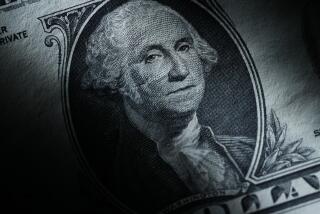Want a High Return? Choose a Healthy S
- Share via
Shopping for the highest rates on certificates of deposit has become a different game these days, thanks to the federal government’s massive bailout of savings and loans.
In the past, high-rate shoppers often ended up putting money in sick thrifts that offered higher rates to attract cash and stay afloat.
But now, putting your money into high-paying troubled thrifts could create more problems than it’s worth. It may be better to go with strong S&Ls; that also pay high rates.
Why? First, high rates offered by sick thrifts will be increasingly hard to find. That’s because the Resolution Trust Corp., the newly formed government agency that has already taken over 262 insolvent thrifts and expects to acquire dozens more, says it will force these sick institutions to lower CD rates to cut their losses.
And even if you get a high rate now from a sick thrift, there’s no guarantee you’ll keep it. If the feds take over insolvent thrifts and merge them with healthier ones, or transfer their deposits, the acquiring institutions now have the option of dumping old CD rates after 14 days. You will be given a choice of either accepting a new, lower CD rate from that institution--possibly as low as their rates on passbook savings accounts--or getting your money back without early withdrawal penalty to invest elsewhere.
In effect, you’re running the risk that your CD--and its high rate--may mature sooner than you thought.
This a radical change from previous federal policy, when acquiring institutions were required to continue paying rates on CDs that had not yet matured.
Of course, if CD rates rise in the interim, getting your money back early won’t be so bad because you can reinvest at higher rates. In fact, average CD rates nationwide rose in the past week for the first time in more than four months--possibly an indication that rate declines have stopped, at least for now.
But if rates fall, you could be stuck with a new CD with a crummier rate.
“With this lower rate threat, consumers should think twice about keeping funds in institutions on the RTC hit list,” says Robert K. Heady, editor of 100 Highest Yields, a North Palm Beach, Fla., newsletter.
“Avoid insolvents if you want to lock in a rate,” adds Paul A. Bauer, editor of Jumbo Rate News, a Coral Gables, Fla., newsletter.
“Why shoot craps?” he adds. “If somebody is basically insolvent, it’s only a matter of time before they’re taken over. The government is talking about closing most of them down within the next year.”
How do you know which institutions are likely to be taken over?
You can get a free list of the 262 thrifts already taken over by the Resolution Trust Corp. by writing the agency at 550 17th St., N.W., Washington, D.C. 20429.
To check on others, request their financial data and look for such things as the ratio of equity capital to assets. Those above 5% are generally considered strongest.
Several independent services study the health of savings institutions and provide ratings for a fee. One is Veribanc. For information about its services, write Box 461, Wakefield, Mass. 01880 or call (800) 44-BANKS.
Jumbo Rate News publishes lists of insolvent savings and loans. It lists 468 institutions as troubled. For information about its lists, write Bauer Financial Reports, P.O. Drawer 145510, Coral Gables, Fla. 33114-5510.
Fortunately, if you’re a high-rate shopper, the news is not all bad.
Any decline in CD rates resulting from government bailouts is expected to be limited to those states with the bulk of the sickest thrifts, such as Texas and Arizona, Heady says. S&Ls; are still expected to offer higher CD rates than banks, on average as much as half a point higher, he adds.
“In markets unaffected by insolvent thrifts, the situation will remain status quo,” Heady says. “If rates change at all, it will be because of the economic climate, not because of bailouts.”
Also, many healthy institutions are still paying among the highest rates in the nation.
For example, three of the five highest yields on six-month CDs nationwide are offered by Southern California institutions generally considered to be in good financial shape, according to 100 Highest Yields. They are Western Financial Savings of Orange (9.41% annual effective yield), Beach Savings Bank of Fountain Valley (9.24%) and Guardian Savings & Loan of Huntington Beach (9.20%).
And finding high rates is not that difficult. Barron’s, the Wall Street Journal and other business newspapers publish lists weekly on institutions paying the highest rates.
Another alternative to help you find high rates: Call your stock broker. Most brokerage houses sell CDs issued by stronger banks and S&Ls; nationwide that are fully insured up to the $100,000 limit. They may not charge a commission either because banks often pay brokerages a fee to sell their CDs.
Charles Schwab & Co.’s CD Rate Hot Line at (800) 543-8700, an example of a CD service offered by a brokerage, provides a recorded message listing rates on CDs offered by the discount brokerage.
Other alternatives: Money market mutual funds or Treasury bills. Nobody has ever lost a cent in them, and they currently are yielding more than comparable CDs (although if interest rates tumble, a CD taken out now may earn you more over several months than a money market fund).
What if you already have deposits in an insolvent thrift?
Stay put. There’s not much you can, or should, do. Your money will continue to be safe as long as it’s under the $100,000 limit in an institution covered by federal deposit insurance.
But if you take your money out now, you will incur early withdrawal penalties that could run as much as six months’ interest for CDs with maturities greater than one year.
More to Read
Inside the business of entertainment
The Wide Shot brings you news, analysis and insights on everything from streaming wars to production — and what it all means for the future.
You may occasionally receive promotional content from the Los Angeles Times.










